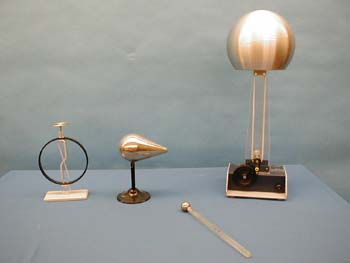Demos: 5A-21 Charge Distribution on a Conductor

A pear-shaped conductor on a insulating stand is charged using an electrostatic generator. Using a proof plane, charge is transferred from various parts of the conductor to an electroscope. It is observed that the greatest amount of charge is transferred when the proof plane touches the region of the conductor having the smallest radius of curvature. It can be inferred that if the conductor has a sharp point, the charge density and hence, the electric field, is very large at the point.
Directions: Charge the pear-shaped conductor using an electro-static generator. Ground the proof plane and the electroscope to remove any excess charge. Then touch the proof plane to the region of the conductor having the largest radius of curvature. Bring the proof plane to the electroscope and transfer the charge. After noting the deflection, re-ground the electroscope and proof plane and repeat the demonstration, touching other areas of the conductor, making sure that you have touched the “pointed” end.
Suggestions for Presentation: Ask the students where on a conductor of non-uniform shape the maximum field intensity should be. You might suggest that regions of large curvature (“flatter”) should be able to hold more charge, indicating a much higher field. In doing the demonstration, start with that region first, concluding with the “sharp point.”
Applications: Lightning rods are often pointed, helping leak off the charge. Also, refer to the shape of the Van de Graff generator. The charging surface is spherical. If any portion of the sphere were to develop a sharp point, there would not be as high a field built up.
Last Updated: Nov 30, 2023 11:25 AM